Differences in the decomposition of green and senescent leaves in streams of Reserva Florestal Adolpho Ducke (Amazonas, Brazil)
DOI:
https://doi.org/10.24979/bolmirr.v12i01.654Keywords:
Aquatic invertebrates, Community structure, Organic substrates, Igarapés, Tropical regionAbstract
Leaves are considered the main energetic resource supply among all the allochthonous organic material available for the small shaded streams. However, their processing is limited by the physical and chemical characteristics of the leaves. Therefore, this research aimed to: i) evaluate the difference in decomposition coefficients between green and senescent leaves; ii) compare richness and density of aquatic invertebrates colonizing decomposing green and senescent leaves. Between November 2012 and January 2013, 12 leaf packages (6 senescent and 6 green) of 14 plant species were installed in 3 streams of the Reserva Florestal Adolpho Ducke (Manaus/AM - Brazil). After 15, 30 and 60 days the submerged packages were removed. The collected material was taken to the laboratory for analyzes of: aquatic invertebrates and leaves' mass remnants. Paired t-test was performed to verify if the decomposition coefficients (k) differed. ANCOVAs were performed to compare: the remaining mass (%), richness and density of aquatic invertebrates between leaf type over time. The green leaves presented higher leaf decomposition rates than in senescent ones. The leaf type influenced the average invertebrates densities. Therefore, green leaves were more susceptible to the colonization of aquatic invertebrates associated with the leaf decomposition process in small Amazonian streams.
Downloads
Downloads
Published
Issue
Section
License
Autores que publicam no Boletim do Museu Integrado de Roraima concordam com os seguintes termos:
1) Autores mantém os direitos autorais e concedem ao Boletim do Museu Integrado de Roraima o direito de primeira publicação, com o trabalho simultaneamente licenciado sob a Creative Commons Attribution License que permite o compartilhamento do trabalho com reconhecimento da autoria e publicação inicial neste periódico.
2) Autores têm autorização para assumir contratos adicionais separadamente, para distribuição não-exclusiva da versão do trabalho publicada nesta revista (ex.: publicar em repositório institucional ou como capítulo de livro), com reconhecimento de autoria e publicação inicial neste periódico.
3) Autores têm permissão e são estimulados a publicar e distribuir seu trabalho online (ex.: em repositórios institucionais ou na sua página pessoal) após a publicação no Boletim do Museu Integrado de Roraima.










